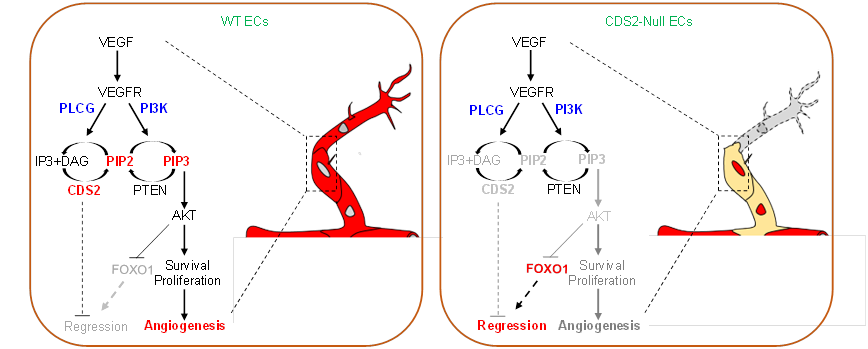
Recently, a group led by Prof. PAN Weijun from Shanghai Institute of Nutrition and Health of the Chinese Academy of Sciences found that genetic deletion of CDP-diacylglycerol synthetase-2 (CDS2) converted the outcome of VEGFA signaling from angiogenesis to vascular regression. The finding was published online in Cell Research.
Previously study demonstrated that zebrafish cds2 mutants (an enzyme controls phosphoinositide metabolism) displayed endothelium-specific morphogenic defects with impaired angiogenesis and reduced VEGFA signal activity mainly caused by the insufficiency of phosphoinositide (PIP2) recycling (PAN et al. Blood, 2012). In this study, live imaging analysis revealed the presence of reverse migration and cell apoptosis in cds2 mutant zebrafish with VEGFA stimulation.
Such vascular regression was further validated in the postnatal retina and implanted tumor models using a Cds2 EC (endothelial cell)-inducible knockout mice. In tumors, CDS2 deficiency blocked tumor angiogenesis, triggered hypoxia and enhanced the level of tumor-secreted VEGFA, which in-turn caused the greater vessel regression, eventually leading to limited tumor growth or regression of tumors.
Mechanistically, VEGFA stimulation reduced phosphatidylinositol (4,5)-bisphosphate (PIP2) availability in the absence of CDS2-controlled-phosphoinositide metabolism, subsequently causing phosphatidylinositol (3,4,5)-triphosphate (PIP3) deficiency and finally resulting in FOXO1 (Forkhead box protein O1) activation-mediated vessel regression.
This study revealed the double edge of VEGFA signaling in vascular homeostasis and suggested that targeting endothelial CDS2 is a novel anti-tumor vessel strategy, showing great potential on tumor therapy.

Working model of VEGFA-triggered vessel regression on CDS2 deficient endothelium. The outcome of VEGFA signaling can be reversed from angiogenesis to vessel regression, which is dependent on CDS2-controlled PIP2 and PIP3 availability and FOXO1 signaling activation. (Image by Prof. PAN's group)
VEGFa-Induced Vessel Regression in cds2 Mutant (Image by Prof. PAN's group)

86-10-68597521 (day)
86-10-68597289 (night)

52 Sanlihe Rd., Xicheng District,
Beijing, China (100864)

